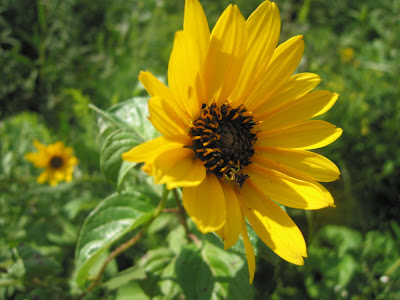Prairie blazing star.
The plan was --- hike through prairie remnants along the lower end of the 13-mile Cinder Path every couple of weeks so as not to miss anything. Didn't do that; missed a lot. But I've done my best in the last couple of days to catch up, finishing up on a beautiful Sunday afternoon. Now if I can just stay on track into October.
I walked three sites because the variety of plants at each differs --- Derby (a few minutes' walk down the trail east of town); county line (right along Highway 65 where Lucas and Wayne counties meet; look for the bulk tank as your landmark) and Humeston (a 10-minute walk north through a tunnel of green to open sky north of the path's southern trailhead).
If you do this, too, tread a little carefully because you're walking through history. This is not recreated prairie; the plants descend directly in these fragments from those that once blanketed much of Iowa and had done so for millenia. If you step on something rare, it'll survive (bison once walked this way) --- but you might spoil it for the next visitor.
Wear sturdy shoes and long pants, too, becuase you'll have to get off the trail to really enjoy all of this and vegetation now ranges from knee- to shoulder-height.
The best show of prairie blazing star is just winding down at the county line site --- thousands of lavendar spkes rising from relatively short grasses between Highway 65 and the trail. These were at their best a couple of weeks ago, but there's still plenty of color and the spikes will remain distinctive into winter.
A lavish display of prairie blazing star.
Rough blazing star is just starting to bloom, but the examples of this I spotted were at the Humeston site and I'll go back when they're more colorful. For some reason, rough blazing star is rarer along the trail.
It's hard to miss rattlesnake master because of its distinctive bloom, past prime here and headed into seed, but the only examples I found were at the Derby site. Roots of this plants reportedly were used by American Indians to treat rattlesnake bites, hence the name.
I'm not good at sorting out all the golds that look like or actually are sunflowers of one variety of another, so you're on your own so far as this one is concerned.
Partridge peas, however, are easy to recognize so I'm really good at that. There still are many of these little guys blooming low in shorter grassy areas.
I'm a sucker for compass plant because of its distinctive foliage, generally aligned north to south hence compass, its distinctive tall spikey bloom stalks and its extreme sturdiness (tap roots go down into prairie soil as far as 14 feet). This big specimen nearly lost except for its spikes at the Humeston site had sent up three bloom stalks which had gotten so tall and topheavy that they had fallen over.
There's nothing about a compass plant that I do not like.
You can get a little better idea of the foliage in this shot of a smaller specimen.
So that's the prairie update for Monday. There's lots more to see and I'll be headed back as southern Iowa fields, roadsides and prairie remnants begin to blaze gold.
Take a prairie walk yourself. You run into interesting people on these outings, too. I had a good talk along the trail Sunday with the mayor pro tem of Humeston. You just never know.










No comments:
Post a Comment